Roles of art in society
Art has many roles and functions in society, ranging from simple description of our lives, to scientific portraits of flora and fauna, to enhancing our everyday lives.
Description
A traditional role of visual art is to describe ourselves and our surroundings. Some of the earliest artworks discovered are drawings and paintings of humans and wild animals on walls deep within prehistoric caves. One recurring image is a hand print: a universal symbol of human communication.
Early Art
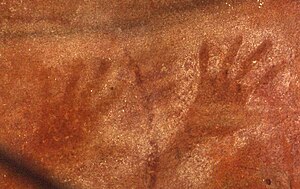
Aboriginal hand stencils, Red Hands Cave, Blue Mountains, New South Wales, Australia
Browse some of the images at the Bradshaw Foundation; see rock art archives in the left navigation menu of that website. The Bradshaw Foundation’s primary objective is to discover, document, and preserve ancient rock art around the world and to promote the study of early humankind’s artistic achievements.
Portraits
Portraits capture the accuracy of physical characteristics, but the very best also transfer a sense of an individual’s unique personality. For thousands of years, this role was reserved for images of those in positions of power, influence, and authority. The portrait not only signifies who they are, but also solidifies class structure by presenting only the highest-ranking members of a society. The portrait bust of Egyptian Queen Nefertiti exemplifies beauty and royalty. The full-length Imperial Portrait of Chinese Emperor Xianfeng not only shows realism in the likeness of the emperor, but also exults in the patterns and colors of his robe and the throne behind him.
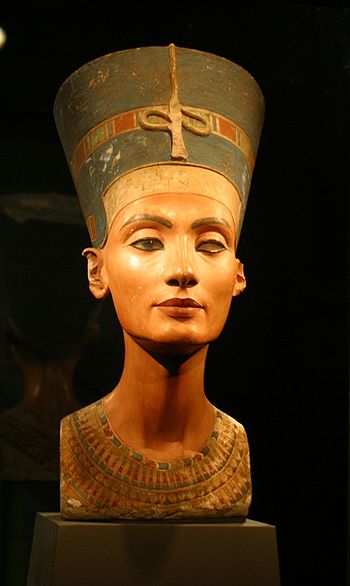
Bust of Nefertiti, painted sandstone, Egypt, c. 1370 BCE. Neues Museum, Berlin
|

Imperial Portrait of Emperor Xianfeng, China, c. 1855. Palace Museum, Bejing
|
Landscapes
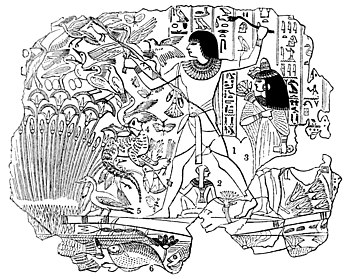
Nebamun Hunting Fowl, fresco, Egypt, c. 1350 BCE. British Museum, London
Landscapes, by themselves, give us detailed information about our natural and human made surroundings; things like location, architecture, time of day, year, or season, plus other physical information such as geological elements and the plants and animals within a particular region. Nebamun Hunting Fowl is loaded with specific plant and animal life in Egypt’s Nile river delta. This wall painting shows the scribe Nebamun as he stands in a reed boat near a thicket of papyrus capturing ducks. His cat actively grabs at two birds as they try to fly away. Amongst the different species are hawks, butterflies, herons, songbirds, and fish. The figure sitting in the boat is his daughter. The larger female figure standing at the stern is his wife. The artist records the scene in great detail; he paints every feather on the birds and every scale on the fish beneath the boat.
Scientific illustrations
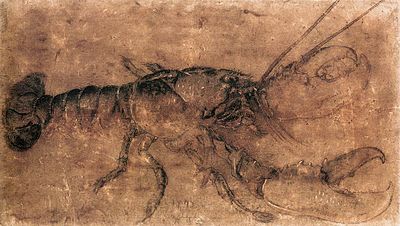
Albrecht Durer, Lobster, 1495. Staatliche Museen, Berlin
Indeed, in many western cultures, the more realistic the rendering of a scene the closer to our idea of the truth it becomes. In the fifteenth century, German artist Albrecht Durer created vivid works that show a keen sense of observation. His Lobster is uncanny in its realism and sense of animation.
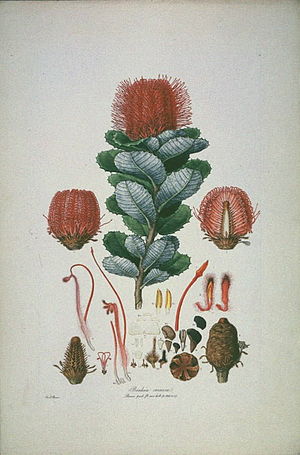
Banksiea coccinea (Illustrationes Florae Novae Hollandiae plate 3)
Out of this striving for accuracy and documentation developed the art of scientific illustration, an important part of scientific communication before the advent of photography. Scientific illustrators concentrate on accuracy and utility rather than aesthetics. They comment on many different types of scientific phenomena.
Enhancing our world
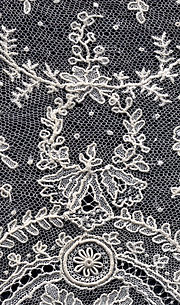
Detail of needle lace
Enhancing the world of our everyday lives is another role art plays. This role is more utilitarian than others. It includes textiles and product design; embellishments to the items we use everyday; and all the aesthetic considerations that create a more comfortable and expressive environment.
Art in Everyday Life
Read about how the Wari peoples of Peru used art to enhance their everyday implements.
Narratives: How artists tell their stories
Artists can combine representation with more complex elements and situational compositions to bring a narrative component into art. The use of subject matter (the objects and figures that inhabit a work of art) as a vehicle for communicating stories and other cultural expressions, is a traditional function of visual art.
The narrative tradition is strong in many cultures throughout the world. It becomes a means to perpetuate knowledge, morals and ethics, and can signify historical contexts within specific cultures. Narrative takes many forms; the spoken or written word, music, dance and visual art are the mediums most often used. Many times one is used in conjunction with another. In his Migration Series Jacob Lawrence paints stark, direct images that communicate the realities of the experience of African Americans in their struggle to escape the repression of the South and overcome the difficulties of adjusting to the big cities in the North.

Russell Lee, Man Drinking at a Water Cooler in the Street Car Terminal, Oklahoma City, photo, 1939. National Archives
In contrast, photographers used the camera lens to document examples of segregation in the United States. Here, the image on film tells its poignant story about inequalities based on race.
Spirit, myth, and fantasy
Tied to the idea of narrative, another artistic role is the exploration of other worlds beyond our physical one. This world is in many ways richer than our own and includes the world of spirit, myth, fantasy, and the imagination: areas particularly suited for the visual artist. You will study more about the other world later in this course.
Art and Other Worlds
Explore how art gives a rich and varied treatment to the ideas of spirit, myth, and fantasy:
- Artist Michael Spafford has spent his career presenting classical Greek myths through painting, drawing and printmaking. His spare, abstract style uses high contrast images to strong dramatic effect.
- A Smiling Figure from ancient Mexico portrays a god of dance, music, and joy.
- Hieronymus Bosch’s painting the Temptation of Saint Anthony, gives the subject matter both spiritual and bizarre significance in the way it is presented. His creative imagination takes the subject of temptation and raises it to the realm of the fantastic.
Roles of art in society
Art has many roles and functions in society, ranging from simple description of our lives, to scientific portraits of flora and fauna, to enhancing our everyday lives.
Description
A traditional role of visual art is to describe ourselves and our surroundings. Some of the earliest artworks discovered are drawings and paintings of humans and wild animals on walls deep within prehistoric caves. One recurring image is a hand print: a universal symbol of human communication.
Activity
Early Art
Browse some of the images at the Bradshaw Foundation; see rock art archives in the left navigation menu of that website. The Bradshaw Foundation’s primary objective is to discover, document, and preserve ancient rock art around the world and to promote the study of early humankind’s artistic achievements.
Portraits
Portraits capture the accuracy of physical characteristics, but the very best also transfer a sense of an individual’s unique personality. For thousands of years, this role was reserved for images of those in positions of power, influence, and authority. The portrait not only signifies who they are, but also solidifies class structure by presenting only the highest-ranking members of a society. The portrait bust of Egyptian Queen Nefertiti exemplifies beauty and royalty. The full-length Imperial Portrait of Chinese Emperor Xianfeng not only shows realism in the likeness of the emperor, but also exults in the patterns and colors of his robe and the throne behind him.
Landscapes
Landscapes, by themselves, give us detailed information about our natural and human made surroundings; things like location, architecture, time of day, year, or season, plus other physical information such as geological elements and the plants and animals within a particular region. Nebamun Hunting Fowl is loaded with specific plant and animal life in Egypt’s Nile river delta. This wall painting shows the scribe Nebamun as he stands in a reed boat near a thicket of papyrus capturing ducks. His cat actively grabs at two birds as they try to fly away. Amongst the different species are hawks, butterflies, herons, songbirds, and fish. The figure sitting in the boat is his daughter. The larger female figure standing at the stern is his wife. The artist records the scene in great detail; he paints every feather on the birds and every scale on the fish beneath the boat.
Scientific illustrations
Indeed, in many western cultures, the more realistic the rendering of a scene the closer to our idea of the truth it becomes. In the fifteenth century, German artist Albrecht Durer created vivid works that show a keen sense of observation. His Lobster is uncanny in its realism and sense of animation.
Out of this striving for accuracy and documentation developed the art of scientific illustration, an important part of scientific communication before the advent of photography. Scientific illustrators concentrate on accuracy and utility rather than aesthetics. They comment on many different types of scientific phenomena.
Enhancing our world
Enhancing the world of our everyday lives is another role art plays. This role is more utilitarian than others. It includes textiles and product design; embellishments to the items we use everyday; and all the aesthetic considerations that create a more comfortable and expressive environment.
Activity
Art in Everyday Life
Read about how the Wari peoples of Peru used art to enhance their everyday implements.
Narratives: How artists tell their stories
Artists can combine representation with more complex elements and situational compositions to bring a narrative component into art. The use of subject matter (the objects and figures that inhabit a work of art) as a vehicle for communicating stories and other cultural expressions, is a traditional function of visual art.
The narrative tradition is strong in many cultures throughout the world. It becomes a means to perpetuate knowledge, morals and ethics, and can signify historical contexts within specific cultures. Narrative takes many forms; the spoken or written word, music, dance and visual art are the mediums most often used. Many times one is used in conjunction with another. In his Migration Series Jacob Lawrence paints stark, direct images that communicate the realities of the experience of African Americans in their struggle to escape the repression of the South and overcome the difficulties of adjusting to the big cities in the North.
In contrast, photographers used the camera lens to document examples of segregation in the United States. Here, the image on film tells its poignant story about inequalities based on race.
Spirit, myth, and fantasy
Tied to the idea of narrative, another artistic role is the exploration of other worlds beyond our physical one. This world is in many ways richer than our own and includes the world of spirit, myth, fantasy, and the imagination: areas particularly suited for the visual artist. You will study more about the other world later in this course.
Activity
Art and Other Worlds
Explore how art gives a rich and varied treatment to the ideas of spirit, myth, and fantasy:
Content is available under the
Creative Commons Attribution Share Alike License.
Privacy Policy | Authors